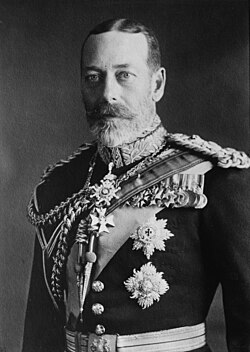
George V received numerous decorations and honorary appointments, both during and before his time as monarch of the United Kingdom and the dominions.

George V received numerous decorations and honorary appointments, both during and before his time as monarch of the United Kingdom and the dominions.
| Styles of King George V | |
|---|---|
 | |
| Reference style | His Majesty |
| Spoken style | Your Majesty |
His full style as king was "George the Fifth, by the Grace of God, of the United Kingdom of Great Britain and Ireland and of the British Dominions beyond the Seas, King, Defender of the Faith, Emperor of India" until the Royal and Parliamentary Titles Act 1927, when it changed to "George V, by the Grace of God, of Great Britain, Ireland and the British Dominions beyond the Seas, King, Defender of the Faith, Emperor of India". [2]
On 4 June 1917, he founded the Most Excellent Order of the British Empire. [11]
May & I drove to B.P. to see Papa & Mother dear, & he was not a bit tired & was in excellent spirits, he gave us all the Coronation medal & he also gave me a new Order the Victorian chain which he has instituted.
{{citation}}: CS1 maint: location missing publisher (link){{citation}}: CS1 maint: location missing publisher (link)